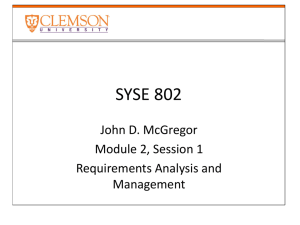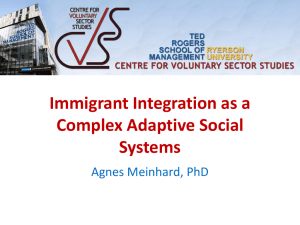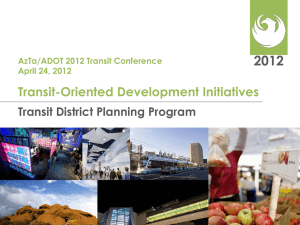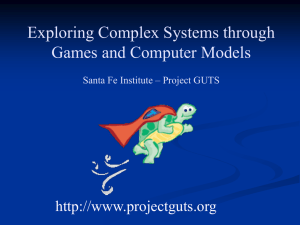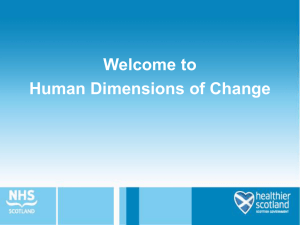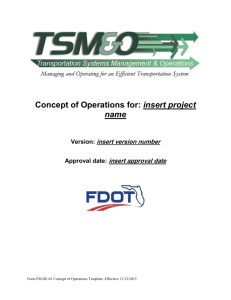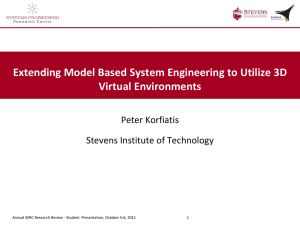ITEM # 3 - FHWA Presentation
advertisement
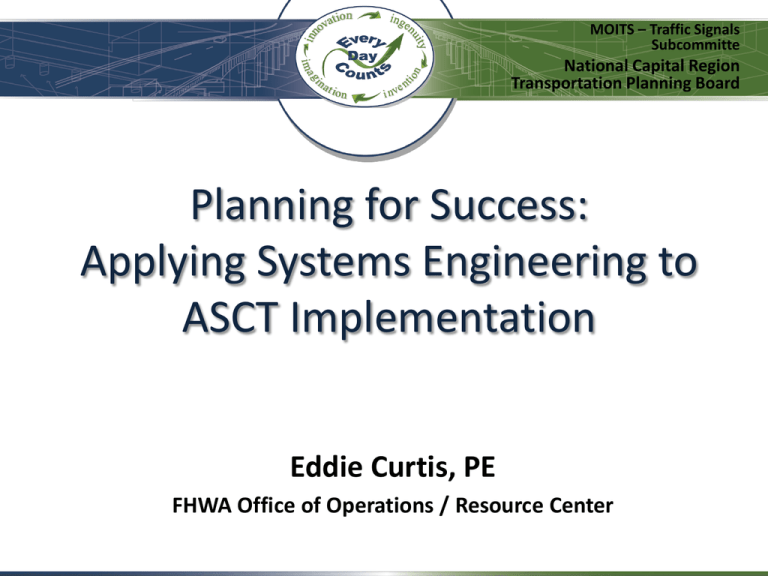
MOITS – Traffic Signals Subcommitte National Capital Region Transportation Planning Board Planning for Success: Applying Systems Engineering to ASCT Implementation Eddie Curtis, PE FHWA Office of Operations / Resource Center Adaptive Signal Control Technology Trigger Event 1 Monitor Traffic Data Collection Modeling / Optimization Implement & Fine Tune 3 2 Update Timing Evaluate Performance Reporting 2 Variability in Demand PM Peak Period Demand PEAK 15 Min 500 Demand (VPH) 450 SB 400 WBLT NBLT 350 300NB EB WB 250 Time 3 Background • • • • • • • • • • ACSLite BALANCE InSync LA ATCS MOTION OPAC RHODES SCATS SCOOT UTOPIA • QuicTrac • NWS Voyage • Multi-criteria Adaptive Control • KLD • Synchro Green •CMU Adaptive •System of the Month 4 US Implementation 1992-2009 Source: NCHRP 403 2010 & FHWA Arterial Management Program 5 What we know about ASCT • Substantial benefits over coordinated TOD operation – Travel time, Delay, Emissions, – Congestion, Safety • Most effective where demand conditions are Variable and unpredictable • Linear Arterials, limited success within tight grids • Under Saturated Systems Deactivated 1992 - 2009 7 What are the Risks to successful deployment of ASCT? • Goals are not well understood. • Problem could be solved with other strategies • Functional Objectives of the system do not align with agency objectives and needs • Loss of other critical functions / features • Constraints not properly addressed • Cost is not managed • Maintenance unachievable 8 Other Risk Issues • • • • • • Technology NEW to most Technology still evolving Most systems have very limited track record Documented history of failed ASCT projects (40%+) Significantly increased complexity Extremely dependant upon infrastructure – Communications systems – Detection – Staff • Not “one size fits all” • Marketing often exceeds performance 9 Successful Deployment • • • • Goals well understood Agency describes its NEEDS Positive response to REQUIREMENTS in RFP Agency VERIFIES that Contractor/Vendor delivers what was required • Agency VALIDATES that the system meets the agencies needs were met • The Agency Operates and Maintains the System to ensure effectiveness over the entire life cycle. 10 Possible Approaches • Consumer Reports – Evaluate Available Technology – Consult with vendors / Distributors – Deploy small scale system (DEMONSTRATION) – Evaluate – Abandon or Expand • Systems Engineering – – – – – – – – – Objectives Needs / Constraints Requirements Design Implement Verification Validation (Operate & Maintain) Abandon or Expand 11 Procurement Strategies 12 Barriers to Adoption of ASCT –Cost –Complexity – Uncertainty about Benefits 13 The Role of Systems Engineering Understanding the problem Managing risk • Projects getting bogged down with shifting requirements • Acquisitions being challenged by unsuccessful bidders/proposers/vendors • Projects not meeting agency needs + it is mandatory for federal-aid projects 940.11 Rule Requirements • All ITS projects must be developed using a Systems Engineering (SE) analysis • The analysis shall be on a scale commensurate with the project scope • SE analysis shall address (7) requirements 15 Seven Requirements of SE Analysis 1. Identify portions of the regional ITS architecture being implemented ; 2. Identification of participating agencies roles and responsibilities; 3. Requirements definitions; 4. Analysis of technology options to meet reqs; 5. Procurement options; 6. Identification of applicable ITS standards and testing procedures; and 7. Procedures and resources necessary for operations and management of the system. 16 Basic Systems Engineering Deliverables • • • • • Concept of Operations Requirements High Level Design Verification Plan Validation Plan 17 Procurement Regulations • Proprietary Materials (23 CFR 635.411) – Certification of no available competitive product • Uniquely fulfills the requirements imposed on the product • Achieves synchronization with existing systems – Public Interest Finding for proprietary purchase despite alternative available competitive products – Limited experimental application • Systems Engineering provides justification Purpose of SE Model Documents • Evaluate need for Adaptive Control • Help agencies identify verifiable, needs-driven requirements for evaluating design and implementation choices • Model documents greatly reduce systems engineering effort by providing wording and documentation… • …but agencies still must identify their needs Model Document Process Build Requirements • Answer questions • About the situation • About you • Select and tailor ConOps statements • Select and tailor requirements Evaluate Alternatives • Evaluate proposed approaches/products against requirements • Solution feasible given constraints? Continue Tailoring Until Solutions… • Fulfill requirements • Are feasible FHWA EDC/ASCT Influence 2010-2012 21 FHWA Every Day Counts Outreach/Support/Technical Assistance Alaska SE used on ASCT Project Puerto Rico Overview of FHWA Model Systems Engineering Documents for ASCT ConOps - Chapter 1 • SCOPE ConOps – Chapter 2 • Reference Documents ConOps – Chapter 3 • • • • 3.1 – The Existing Situation 3.2 – Limitations of the Existing System 3.3 – Proposed Improvements 3.4 – Vision, Goals and Objectives for the proposed system. • 3.5 – Strategies to be applied • 3.6 – Alternative strategies considerd Chapter 4 – Operational NEEDS • 4.1 – Adaptive Strategies » Sequence Based Control » Non-Sequence Based Control • • • • • • 4.2 – Network Characteristics 4.3 – Coordination Across Boundaries 4.4 – Security 4.5 – Queuing Interactions 4.6 – Pedestrians 4.7 – Non-Adaptive Situations ConOps - Chapter 4 (cont) • • • • • • • • 4.8 – System Responsiveness 4.9 – Complex Coordination Features 4.10 – Monitoring and Control 4.11 – Performance Reporting 4.12 – Failure Notification 4.13 – Preemption and Priority 4.14 – Failure & Fallback 4.15 - Constraints ConOps - Chapter 4 (cont) • 4.16 – Training and Support • 4.17 – External Interfaces • 4.18 Maintenance ConOps – Chapter 5 • Envisioned Adaptive System Overview – 5.1 Size and Grouping – 5.2 Operational Objectives – 5.3 Fallback Operation – 5.4 Crossing Routes and Adjacent Systems – 5.5 Operator Access – 5.6 Complex Coordination – 5.7 Organizations Involved ConOps – Chapter 6 • Adaptive Operational Environment – 6.1 Stakeholders – 6.2 Physical Environment ConOps – Chapter 7 • Adaptive Support Environment – – – – – – – – – 7.1 System Architecture Constraints 7.2 Utilities 7.3 Equipment 7.4 Computing Hardware 7.5 Software 7.6 Personnel 7.7 Operating Procedures 7.8 Maintenance 7.9 Disposal ConOps – Chapter 8 • Operational Scenarios – Congested Conditions – Light balanced flows – Pedestrians – Special Events Verification / Validation • Requirements • Needs MOEs Route travel time Route travel delay Route average speed Route travel time reliability Link travel time, delay Number of stops per mile on route Traffic volume on route (throughput) Time to process equivalent volume Data Sources Import travel time data from Bluetooth scanner Import trajectory data from GPS probe Operational Objectives Pipeline Multiple objectives by TOD Accommodate long-term variability Import trajectory data from GPS probe Pipeline Manage queues Prevent oversaturation Handle incidents and events Multiple objectives by TOD Import count data from tube counter file Pipeline Manage queues Prevent oversaturation Handle incidents and events Multiple objectives by TOD Percent arrivals on green, by link V/C ratio by movement Platoon ratio, by link Phase green to occupancy ratio by movement Reliability of phase metrics Import high-resolution signal timing and detector data Pipeline Access equity Multiple objectives by TOD Accommodate long-term variability Mapping MOEs to Objectives Funding Success Begins with Proper Planning 36 Project Implementation at Local Regional, State and Federal Levels Testing Needs Req’mts Testing Design and Implementation Stakeholder Input on Needs ITS Project Life Cycle Monitoring and Evaluation 38 NHI Traffic Signal Courses •http://www.nhi.fhwa.dot.gov/ • Traffic Signal Design and Operation (133121) • Traffic Signal Timing Concepts (133122) • Implementing Successful Advanced Traffic Signal System Projects Including Adaptive Control (133123) • Successful Traffic Signal Management: The Basic Service Approach (133125) GOST Goal Objective Strategy Tactic What we are trying to achieve What needs to be done to achieve the goal Capabilities put in place to achieve the goal Specific methods to achieve the goal Goal • Keep the cars moving and if they stop not for very long. Objective • Specific Measurable Achievable Realistic Timebound – Provide Smooth Flow along the arterial during periods moderate demand. – Provide Equitable Access to land use to minimize delay during periods of significant demand for left-turn and sidestreet movements. – Maximize Throughput during periods of moderate to heavy demand minimizing phase failures. – During periods of heavy demand Manage Queues to prevent blocking of upstream intersections or movements. Strategy • Smooth Flow - Provide green bands in both directions such that platoon movement is rarely hindered or stopped. • Equitable Access – Provide green splits that serve left-turns and side-streets efficiently, coordination is generally provided but not at the expense of side streets and left turns. Tactic • Select Resonant Cycle Length (Shelby, Bullock, Gettman) (TRB TSSC) – Single & Double Alternates (McShane) • No internal Queues • C = 2* X Distance / Platoon Speed • Offset = distance /platoon speed (* 4 for double alternate or other factor) (Signal Spacing drives cycle length) NHI Traffic Signal Courses •http://www.nhi.fhwa.dot.gov/ • Traffic Signal Design and Operation (133121) • Traffic Signal Timing Concepts (133122) • Implementing Successful Advanced Traffic Signal System Projects Including Adaptive Control (133123) • Successful Traffic Signal Management: The Basic Service Approach (133125) Questions? http://www.fhwa.dot.gov/everydaycounts Eddie Curtis, P.E. Traffic Management Specialist (404) 562-3920 eddie.curtis@dot.gov

